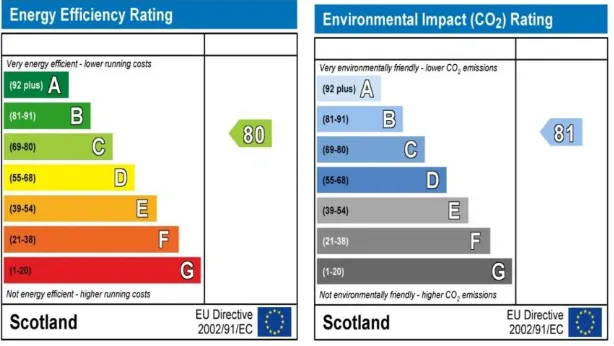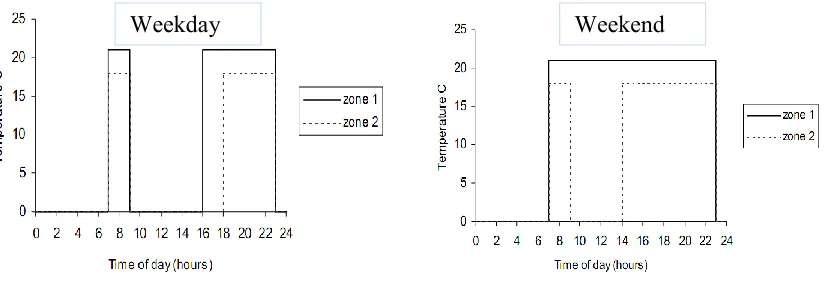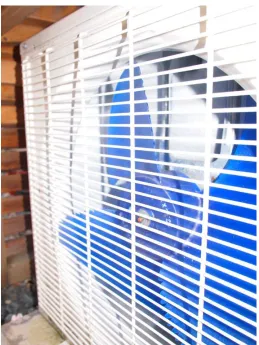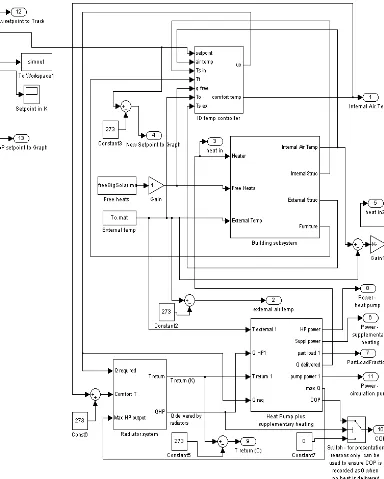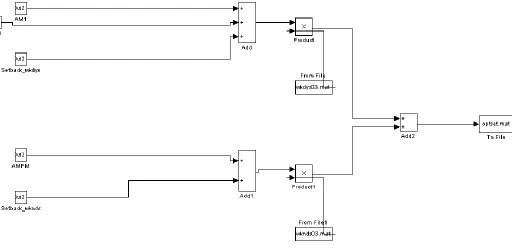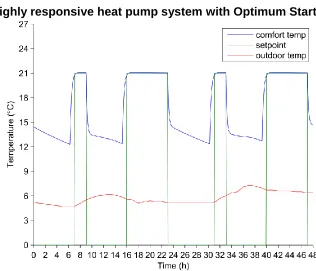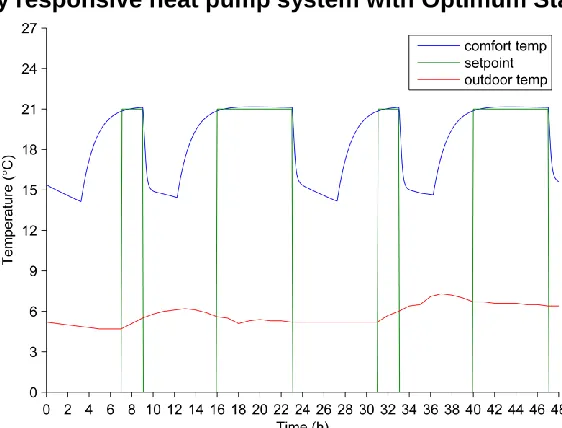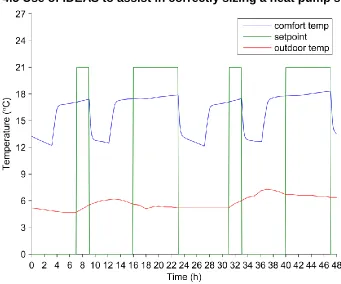Simplified Modelling of Air Source Heat Pumps Producing Detailed Results
Gavin Murphy¹, Eric Baster¹, John Allison¹, Sean Counsell² ¹BRE Centre of Excellence in Energy Utilisation, Department of Mechanical and Aerospace Engineering,
University of Strathclyde, Glasgow
²Nuffield Science Bursary Student, CGGS, West Kirby, Wirral Gavin.Murphy@Strath.ac.uk
Abstract
Created by the Building Research Establishment (BRE), the Standard Assessment Procedure (SAP) is the UK Government‟s recommended method of assessing the energy ratings of dwellings. Modelling future complex dwellings, and their servicing systems, will require a more advanced calculation which is as simple as SAP to use but can produce more detailed results. This paper extends a novel advanced
dynamic calculation method (IDEAS – Inverse Dynamics based Energy Analysis and Simulation) of assessing the controllability of a building and its servicing systems. IDEAS produces SAP compliant results and allows confident (i.e. calibrated in SAP) predictions to be made regarding the impact of novel heating and renewable energy systems. This paper describes the addition of an Air Source Heat Pump (ASHP) model to IDEAS. This allows for detailed analysis to be made of ASHPs in a SAP compliant framework. The benefits of using the IDEAS method is highlighted with capabilities outwith the scope of SAP also possible. For example, IDEAS can be used as sizing tool for a heating system in a building.
Keywords Dwellings, Air Source Heat Pump (ASHP), Standard Assessment Procedure (SAP), Advanced Controllability, Optimum Start
1.0 Introduction
[image:1.595.152.459.565.738.2]The European Directive on the Energy Performance of Buildings (1), referred to as the Energy Performance of Buildings Directive (EPBD) stipulates that all European member states must produce an Energy Performance Certificate (EPC) and make this available to the next prospective occupier. In the UK, SAP is the procedure used to generate an EPC for all dwellings.
Studies have also shown that there can be variances in results between SAP and Dynamic Simulation tools (2). Simplified symbolic assessment methods have been shown to be relevant for controllability analysis (3, 4) and for the assessment of buildings (5). A benefit of symbolic modelling is that a symbolic model can rapidly (6) and thoroughly determine the effect of disturbances such as free heats gains or external temperature; it does not need to know what they are. Relatively simple symbolic models are required for the buildings industry, symbolic models are powerful and have to be low order (7).
The SAP methodology may benefit by the creation of a tool to simply estimate the potential impact of innovative technologies to energy estimation and regulation. This tool could also address the discrepancies raised with the current SAP methodology. A novel advanced dynamic calculation method (IDEAS – Inverse Dynamics based Energy Analysis and Simulation) of assessing the controllability of a building and its servicing systems has been developed. The IDEAS method produces results that are comparable to SAP. The purpose of the IDEAS tool is to suggest where advanced controllability of dwellings and a dynamic framework could supplement SAP. The IDEAS calculation method is based upon current SAP parameters to produce a simple to use method which is familiar to current users of SAP: most importantly IDEAS has been calibrated with over a large range of test cases. IDEAS allows for an extension of SAP in many areas such as: the use of various climate files with values that change on a minutely and not monthly or yearly basis, the flexibility to amend the heating setpoint which is tracked (for example, comparisons can be made between tracking a constant setpoint of 21 degrees vs. the Standard varying SAP setpoint) and the additional of advanced controllability algorithms to be applied to a SAP environment. IDEAS has been described in depth (8, 9).
The focus of this paper is the SAP compliant treatment of ASHPs using the IDEAS advanced calculation method. ASHPs have been monitored and modelled in
complex detailed dynamic simulation tools (10). Additionally the major factors which affect the uptake of heat pump technology in the UK domestic sector have been highlighted (11). The extension of the IDEAS model detailed in this paper is the
addition of an Air Source Heat Pump (ASHP) model with an Optimum Start algorithm.
From the outputs of this research, recommendations are made as to where the SAP methodology could enrich its treatment of ASHPs in the UK.
1.1 SAP Treatment of ASHPs
Heat Pumps are integrated into the SAP methodology and detailed in SAP 2009 Appendix N, Micro-cogeneration (or micro-CHP), “Heat pumps provide space and/or water heating with efficiencies in excess of 100% as they transfer heat from outside the heated envelope of the dwelling” (12). SAP defines a “heat pump package” as a heat pump system in conjunction with other components such as an auxiliary heater. The SAP methodology demands that the Standard Occupancy Temperature is met; if the heat pump cannot supply the required heat then SAP assumes that an auxiliary heater is used as a top up. SAP calculations are based upon data provided in a Product Characteristic Database where the Plant Size Ratio (PSR) is an important factor. The PSR is calculated in SAP as the max power of the heat pump divided by the design heat loss of the dwelling (taken as the average annual heat loss
coefficient), multiplied by a temperature difference of 24.2K. SAP 2009 is a monthly calculation procedure which is used to produce an overall SAP rating which
1.2 Objective
ASHPs present a challenge to a quasi-steady state tool such as SAP. The efficiency (coefficient of performance or COP) and maximum output of a real ASHP is not constant, but varies widely in response to changes in external air temperature and heating system return temperature (as well as being influenced by other factors such as humidity). SAP must reduce this transitory behaviour to representative average values. However selecting representative values is problematic, as ASHP
performance is very sensitive to system design and specification. This is
demonstrated by recent field trials (EST), which revealed annual system efficiencies for ASHP installations ranging from 1.2 to 3.2.
An advanced calculation methodology and a dynamic framework would allow SAP-compliant results to be produced dynamically, taking full account of the transient nature of ASHP performance and the specifics of a particular installation. This could enable a more accurate analysis of the appropriateness of an ASHP for a particular dwelling, especially as localised weather profiles and tailored internal gains can be used. Furthermore, the ability to examine the transitory behaviour of an ASHP system would enable a deeper understanding of the factors affecting performance, allowing it to be maximised.
The IDEAS advanced calculation methodology was selected to produce SAP compliant dynamic results for ASHPs. The main reasons were the calibration of IDEAS with SAP; the importance of the inverse dynamics RIDE controllability
foundation of IDEAS to allow the perfect control of heating systems such as ASHPs; and the flexibility of IDEAS given from its implementation in Matlab / Simulink (13). This paper extends a simplified dynamic method of assessing the controllability of a building and its servicing systems, such as ventilation, heating and renewable systems. The extension is the addition of an Air Source Heat Pump model with an Optimum Start Algorithm. Results are presented using the IDEAS advanced calculation method to suggest where a dynamic framework could supplement the SAP treatment of ASHPs.
2.0 METHODOLOGY
2.1 Rationale of a Dynamic Approach to supplement SAP
The SAP Methodology is well established and is the culmination of three decades of research commencing with BREDEM 1 (14, 15). SAP is based on BREDEM
(Building Research Establishment Domestic Energy Model). BREDEM 12 and BREDEM 8 have been described in depth (16, 17). SAP is the recognisable tool used in the UK to generate EPCs and for building professionals to meet buildings compliance. The UK buildings industry is familiar with SAP. Due to the role of SAP, it is possible to work within the current regulatory framework by utilising the current SAP procedure as a foundation for the IDEAS Methodology. SAP is assumed to be fully steady state, but in fact, SAP has many factors (inherited from BREDEM) which are used dynamically to calculate factors such as the Mean Internal Temperature of the dwelling or the responsiveness of a heating system. The current SAP
as impact of casual heat gains and solar gains by inheriting this from the current SAP model. Therefore, IDEAS is more advanced but is also backwards compatible with the current SAP model. There is also scope for a dynamic version of SAP to be used at a building‟s design stage; there is currently no design version of SAP.
Controllability assessment at the conceptual design stage could help to prevent current problems of poor control and high-energy costs that arise later in the detailed design phase or at post construction stage. The cost of removing poor control
performance in the later stages of design is normally excessive and must be avoided if possible (18).
2.2 Advanced Controllability in SAP based IDEAS framework
The engineering science established by IDEAS is based on „A Perfect Control Philosophy‟. This philosophy aims to establish for a given design, if perfect control is feasible whilst maintaining stability for the closed loop control system. The value of this feasibility strictly is in allowing the designer to assess the ease in which perfect control could be achieved. The assumption is that the easier it is to achieve perfect control then in reality the easier the real system will be to control.
In order to estimate the energy required to maintain an ideal standard occupancy temperature and time profile (such as that defined by BREDEM), the dynamics of the system have to be inverted to establish what power input is required at a system time to achieve the target temperature. This requires the solution to PERFECT control, which can be obtained using RIDE (19) control algorithms. The RIDE Theory utilises Inverse Dynamics, firstly defining the system output in state-space form. A feedback control system can only control (i.e. track) what it feeds back as measured system outputs.
[image:4.595.77.489.508.649.2]SAP is based on a 2 zone model as defined in BREDEM, with zone 1 being the living area of the home and zone 2 the bedrooms. BREDEM defines the lower limit of heating these areas to be 21°C and 18°C for 2 heating profiles, covering the weekday and weekend.
Figure 2 - BREDEM Weekday and Weekend heating profile for two zones (17)
The IDEAS model is expanded in this paper so an ASHP is modelled to perfectly track a SAP standard occupancy profile (figure 2). Using this dynamic approach, SAP compliant results can be produced and analysed to allow for more appropriate ASHP applications in the UK.
2.3 ASHP model
The development of the ASHP model has been described in detail previously (20), however important features are highlighted below. A „black-box‟ approach was employed: the parameters of the refrigerant cycle itself were not of interest, only performance and how it varies as external conditions change.
The model is based around regression models of COP and maximum output. These take distribution system return temperature and external air temperature as predictor variables. This method is similar to that used in other simulations of
building-integrated ASHP performance (10). Return temperature is calculated by an inverse model of typical wet central heating system radiators. This makes use of a dynamic heat transfer coefficient to take account of the decline in radiator „effectiveness‟ at low temperature shown in data published by suppliers
Published results from the independent testing of 30 heat pump units (21) was used for the regression analysis. Each heat pump is tested at 8 different test points (figure 3), as specified in the European Heat Pump Association test regulations. Though this number of data points is far fewer than would ideally be required to model the
performance of an individual ASHP unit, when results for all 30 are combined, the resulting regression models seem likely to be a good representation of „average‟ ASHP performance.
Test point
External air T (°C)
Relative hum. (%) Output T (°C) Return T (°C) heat output (kW) COP
1 7 89 35 30 6.3 4.7
2 2 84 35 30.8 5.2 3.9
3 -7 75 35 31.8 4.0 3.1
4 -15 - 35 32.5 3.1 2.6
5 7 89 45 40.3 5.9 3.6
6 20 50 55 49.1 7.4 3.7
7 7 89 55 50.6 5.5 2.9
[image:5.595.65.532.373.523.2]8 -7 75 55 52.1 3.6 2.1
Figure 3 - Sample of ASHP test data (21)
The key output of the model is the electrical power P drawn by the ASHP. This is calculated at each time step using the definition of COP:
̇
Here ̇ is taken to be the smaller one of two values: either the rate of heat transfer required in order to maintain the desired setpoint in the dwelling, or the ASHP‟s maximum output. If required the model can be set so that where the ASHP cannot meet the heat load, the shortfall is met by supplementary heating.
associated defrost period on performance is captured. Some amount of frosting behaviour is therefore assumed in the model. However, this is not a full treatment as frosting is affected by humidity as well as air temperature, and the eight test points do not provide enough variation for humidity to be included as a predictor variable in the regression models. It has been suggested that ASHP performance can drop
[image:6.595.71.330.187.532.2]significantly if very high humidity combines with air temperatures close to zero. The link between humidity, frosting and performance is a key area in the continuing development of this model.
Figure 4 - Frost build up on ASHP. Image taken at 5°C in Dunoon, Scotland
Figure 4 above highlights the frost build-up of an ASHP installed in Dunoon at a temperature of 5°C. Data is currently being collected in a monitoring study of
dwellings in Scotland to assess the impact of climate parameters such as humidity on ASHP performance.
2.4 Importance of Optimum Start
Optimum Start is required so that the IDEAS model can satisfy the comfort criteria as determined by SAP (figure 2). Minimal Optimum Start is required for fast acting heating emitters, such as gas boilers (defined by SAP as having the same
The application of Optimum Start in IDEAS has been described previously (9). This work is a novel application of an ASHP model in IDEAS that highlights the necessity of an Optimum Start algorithm.
3.0 ASHP Modelling in IDEAS with Optimum Start
With the Optimum Start algorithm implemented in IDEAS, the responsiveness of the heating system can be taken into account so that the demand times in an intermittent demand profile are met at the requested time; i.e. if 21° is demanded at 7am then the Optimum Start algorithm will determine when the heating system has to be switched on for this to be achieved.
[image:7.595.166.550.216.695.2]A previous study (20) made use of IDEAS to develop heat pump and radiator modules to simulate the performance of retrofit air source heat pumps (ASHPs) in homes, which are typical of the UK dwelling stock. The focus of this paper is the
Figure 5 – Addition of Optimum Start to 4th
addition of optimum start to this work and an analysis of the results with respect to SAP.
The major addition to the prior heat pump work is the additional of an Optimum Start algorithm as highlighted in the figure above. With the Optimum Start algorithm implemented, the responsiveness of the ASHP can be taken into account so that the demand temperatures in an intermittent demand profile are met when requested; i.e. if 21° is demanded at 7am then the optimum start algorithm will determine when the heating system has to be switched on for this to be achieved. Optimum start is self-contained in an additional model as shown in the figure below.
Logic is required for the Optimum Start implementation to account for the differences between the weekday and weekend demand as defined by the SAP standard
occupancy profile. From Figure 6, two logic streams can be seen, with the top logic stream focusing on the creation of the Optimum Start setpoint for the weekdays and the bottom for the weekends.
The weekday logic stream takes into account that there is an AM and PM Optimum Start required by SAP (7am->9am & 4pm->11pm). Similarly the weekend logic stream defines the Optimum Start where there is always only one period of standard occupancy per day (7am->11pm). The „Setback_wkends‟ and „Setback_wkdays‟ blocks in this model account for the additional time the Optimum Start must
[image:8.595.46.558.210.460.2]compensate the original setpoint in order to achieve the requested temperature by the demand time. . The file „wkdys03.mat‟ is used to filter the calculated setpoint so that the correct setpoint is chosen based on whether it is a weekday or weekend. These are then added together to create „optset.mat‟: this is the new setpoint which is tracked perfectly by IDEAS, taking into account the Optimum Start requirement of the ASHP. The Optimum Start setpoint is dynamic and varies based upon the responsiveness and the maximum output of ASHP.
Page 9 of 14
4.0 Results – addition of Optimum Start to Heat Pump Model
Two heat pump scenarios were run to determine the impact of Optimum Start to the energy consumption and mean internal temperature of a typical dwelling, (structure U-Value 1W/m2K).
1. ASHP with a highly responsive heat emitter: with and without Optimum Start 2. ASHP with a slowly responsive heat emitter: with and without Optimum Start
4.1 Highly responsive heat pump system without Optimum Start
[image:9.595.95.443.175.439.2]4.2 Highly responsive heat pump system with Optimum Start
Figure 7 – Highly responsive heat pump system WITHOUT Optimum Start; Average MIT = 19.06, Total Energy Consumption = 14170kWh
Figure 8 – Highly responsive heat pump system WITH Optimum Start; Average MIT = 19.08,
[image:9.595.101.417.483.754.2]As highlighted by the similarity of Figures 7 and 8 above (highly responsive heat pump system with and without Optimum Start), as expected there is little difference in results for a highly responsive heat pump system if Optimum Start is applied or not. Although, there is a minimal increase in overall MIT and energy consumption for the case when optimum start is employed.
4.3 Slowly responsive heat pump system without Optimum Start
Figure 9 demonstrates that without the implementation of an Optimum Start
algorithm, a poorly responsive heat pump will never be able to meet the set point in time. Figure 9 also shows that the AM set point start time of 7am is never reached and the PM set point start time of 4PM is not reached until approximately 5.30PM. Moreover, Figure 9 demonstrates that a slowly responsive heat pump system modelled in IDEAS without the addition of Optimum Start will never reach the setpoint times required.
[image:10.595.110.415.140.375.2]4.4 Slowly responsive heat pump system with Optimum Start
[image:10.595.125.406.540.754.2]Figure 9– Slowly responsive heat pump system WITHOUT Optimum Start, Average MIT = 18.63, Total Energy Consumption = 13477kWh
Figure 10 demonstrates the necessity of Optimum Start to a heat pump system which is slowly responding. With Optimum Start applied to a slowly responsive heat pump, the average MIT is seen to increase by over 1° over the course of a year (in
comparison with a slowly responsive heat pump system without Optimum Start), improving the comfort of the occupants. There is an energy penalty of 14% over the course of the year for the average MIT increase.
The addition of Optimum Start to the heat pump model has therefore been a success and has been highlighted as being imperative for heat pump systems which respond slowly.
4.5 Use of IDEAS to assist in correctly sizing a heat pump system
Figure 11 demonstrates the use of the IDEAS tool to assist in the sizing of a heat pump system. It can be seen in figure 11 that this selected heat pump is undersized for the building in question. There is not enough power in the heating system for the demand profile to be met. IDEAS could be used to correctly size any heating
system, based upon the specific parameters entered for a particular building such as areas and U – Values. This is an extension of the SAP methodology where the sizing of heating systems and the analysis of transitory response of that heating system is not possible.
5.0 Conclusions
[image:11.595.69.410.248.532.2]This paper presents the treatment of ASHPs by the SAP methodology and demonstrates the implementation of an ASHP model to IDEAS with an Optimum Start algorithm implementation.
Figure 11 – example of an undersized Air Source Heat Pump in IDEAS,
This paper highlighted the use of the IDEAS model to analyse the performance of heat pumps in a UK domestic scenario. The modular and open design of the IDEAS method has been demonstrated by the addition of Optimum Start. An Optimum Start algorithm was added to the heat pump work created previously (20). This
demonstrated the modular approach taken in the development of IDEAS. The results highlight that the addition of Optimum Start can be important to heat pump systems which respond slowly.
This work also highlighted the importance of the method employed in IDEAS: once perfect control is achieved the theoretical maximum performance of a heating system is given. From this theoretical maximum, it is then possible to degrade the
performance by the use of factors such as boiler efficiency as provided by the SEDBUK database. This methodology is a good fit with that employed by SAP.
The main benefits of the advanced modelling of ASHPs in IDEAS are to the building professional who wishes to quickly gauge the transient and yearly impact of installing an ASHP in the UK. This is currently not possible in SAP due to the quasi steady state nature employed and its inability to process and output dynamic data at a timestep lower than one month. The added flexibility of the modelling of ASHPs in IDEAS is the flexibility to use local weather profiles and user generated free heat profiles. This will allow the practitioner to determine if an ASHP is appropriate to install in various parts of the UK as the climate difference, and hence ASHP
performance, can be large. Also, allowing the practitioner to use the IDEAS tool with varying free heats allows the appropriateness of an ASHP to be determined based upon the proposed occupants of a dwelling; the acceptance of an ASHP (and corresponding free heat profile, and occupancy profile to be modelled) will vary dramatically if the occupants are pensioners or working 9-5. This added detail is possible in IDEAS and is an extension of the capabilities of SAP.
The fundamental aspect of this modelled of an ASHP in IDEAS is the addition of optimum start, without this addition it is difficult to model heat pump systems which respond slowly. The results from this paper have highlighted the importance of Optimum Start and of correctly sizing of a ASHP for a building.
This work has suggested where SAP could be updated to cope with future complex dwellings which will continue to drive towards lower carbon emissions.
5.1 Discussion and Future Work
As highlighted in the conclusions, this work demonstrates the flexibility of the IDEAS calculation method with respect to the modelling of an ASHP with Optimum Start implementation. Due to the importance of the tool used to model homes in the future, recent research demonstrates the importance of SAP and its current place in the regulatory framework (22). This work highlights the dwelling design versus dwelling performance gap and the importance of rigour in methods such as SAP. New tools such as IDEAS can be an important part of this discussion and can suggest how SAP could evolve in the future. The IDEAS method could be adapted to form the framework for a SAP compliant design tool; additional research and discussion is required to determine if this would be welcomed by building
on performance; this future work will be based upon real measured test data as highlighted in Figure 4 (23).
Figures 7 to 11 display output from IDEAS based upon a poorly insulated dwelling coupled with a cold external temperature. This accounts for the relatively quick temperature decays shown in these figures. The focus of this paper was the addition of an Optimum Start algorithm; an Optimum Stop algorithm could also be researched to ensure that a heating system is optimally switched off. Further analysis and
comparison of IDEAS output in better insulated dwellings could be made using the IDEAS framework. The temperature decays of various dwelling types under various temperature profiles can be contrasted using IDEAS.
Further analysis is required into the integration of the optimum start algorithm in respect of a wider number of dwelling heating sources and emitters, including additional renewables. The effect of Optimum Start on a dwellings energy use and temperature levels can also be researched further.
Acknowledgement
BRE TRUST for the funding of this research
References
1. European Parliament. DIRECTIVE 2002/91/EC OF THE EUROPEAN PARLIAMENT AND OF THE COUNCIL of 16 December 2002 on the energy performance of buildings. Official Journal of the European Communities. 2003. 2. Murphy GB, Kummert M, Anderson B, Counsell J. A comparison of the UK Standard Assessment Procedure and detailed simulation of solar energy systems for dwellings. Journal of Building Performance Simulation. 2010;4(1):75-90.
3. Tashtoush B, Molhim M, Al-Rousan M. Dynamic model of an HVAC system for control analysis. Energy. 2005;30(10):1729-45.
4. Hudson G, Underwood C, editors. A simple building modelling procedure for MATLAB/SIMULINK1999.
5. Counsell JM, Khalid YA, Brindley J. CONTROLLABILITY OF BUILDINGS, A multi-input multi-output stability assessment method for buildings with slow acting heating systems. Simulation Modelling Practice and Theory. 2010.
6. Tindale A. Third-order lumped-parameter simulation method. Building Services Engineering Research and Technology. 1993;14(3):87.
7. Khalid Y. Controllability of Building Systems. Glasgow: Strathclyde; 2011. 8. Murphy G, Khalid Y, Counsell J. A Simplified Dynamic Systems Approach for the Energy Rating of Dwellings Building Simulation 2011; Sydney, Australia2011. 9. Murphy G, Counsell J. Symbolic Energy Estimation Model with Optimum Start Algorithm Implementation CIBSE Technical Symposium, DeMontfort University, Leicester UK – 6th and 7th September2011.
10. Kelly NJ, Cockroft J. Analysis of retrofit air source heat pump performance: Results from detailed simulations and comparison to field trial data. Energy and Buildings. 2011;43(1):239-45.
11. Singh H, Muetze A, Eames PC. Factors influencing the uptake of heat pump technology by the UK domestic sector. Renewable energy. 2010;35(4):873-8. 12. BRE. The Government‟s Standard Assessment Procedure 2009 for Energy Rating of Dwellings – SAP 2009: BRE; 2011.
14. Uglow CE. Energy use in dwellings: An exercise to investigate the validity of a simple calculation method. Building Services Engineering Research and Technology. 1982;3(1):35.
15. Uglow CE. The calculation of energy use in dwellings. Building Services Engineering Research and Technology. 1981;2(1):1.
16. Anderson BR, Chapman PF, Cutland NG, Dickson CM, Doran SM, Henderson G, et al. BREDEM 8 - Model Description: BRE; 2001.
17. Anderson BR, Chapman PF, Cutland NG, Dickson CM, Henderson G, Henderson JH, et al. BREDEM 12 - Model Description: BRE; 2001.
18. French MJ. Conceptual design for engineers: Springer Verlag; 1999.
19. Muir E, Bradshaw A. Control law design for a thrust vectoring fighter aircraft using robust inverse dynamics estimation (RIDE). ARCHIVE: Proceedings of the Institution of Mechanical Engineers, Part G: Journal of Aerospace Engineering 1989-1996 (vols 203-210). 1989-1996;210(47):333-43.
20. Baster E. Modelling the performance of Air Source Heat Pump Systems Glasgow: University of Strathclyde; 2011.
21. Warmenpumpen Testzentrum. Test Results of Air to Water Heat Pumps based on EN 14511. 2011 [cited 2011 10/05]; Available from:
http://www.ntb.ch/fileadmin/Institute/IES/pdf/PruefResLW110620_Eng.pdf.
22. Zero Carbon Hub. Carbon Compliance for Tomorrow's New Homes: NHBC foundation2010.
